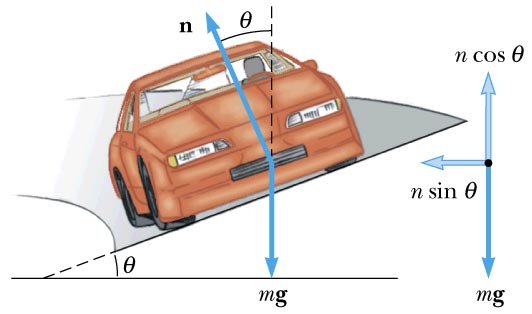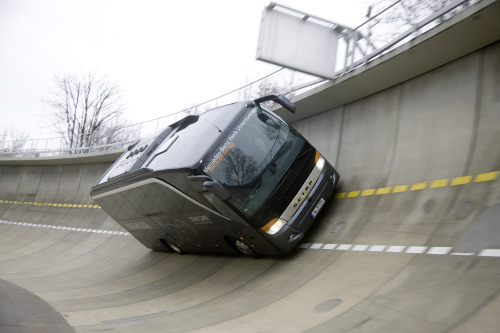When a car goes around a banked circular curve at the proper speed for the banking angle what force cause it to follow the circular path. The friction force from the road c.
Physics questions and answers.

. Two banked curves have the same radius. Cos 40 105098 7883N. One car has tires with excellent traction while the other car has bald slippery tires.
M v 2 r m g tan. Tan v 2 g r. But the wear and tear of tires caused by this friction increases the maintenance cost of the vehicles and increases the risk of sudden accidents at the curved points of the roads.
At what speed can this. When a car goes around a banked circular curve at the proper speed speed for the banking angle what force cause it to follow the circular path. Which component force provides the acceleration needed for circular motion.
Next I tried to find out the horizontal component of the normal force by doing. A banked curve is designed for one specific speed. Curve A is banked at an angle of 11 and curve B is banked at an angle of 16.
No force causes the car to do this because the car is traveling at constant speed and therefore has no acceleration. The friction force from the road. A the friction force from the roadb gravityc the normal force from the road.
When a car goes around a circular curve on a level road the frictional force of the road on the car increases when the cars speed increases. Two clowns are launched from the same spring-loaded circus cannon with the spring compressed the same distance each time. D No force causes the car to do this because the car is traveling at constant speed and therefore has no acceleration.
First I figured out the normal force being exerted on the car using the equation above. If the road is frictionless due to ice the car can still negotiate the curve if the horizontal component of the normal force on the car from the road is equal in magnitude to. I figured out the angle by using certain geometrical properties.
When the car moves on the banked circular path the vertical component of normal force Nsin θ provides the required centripetal force to maintain the circular motion of the car. A car can travel around curve A without relying on friction at a speed of 185 ms. When a car goes around a banked circular curve at the proper speed for the banking angle what force cause it to follow the circular path.
A car of mass m goes around a banked curve of radius r with speed v. Cos x adjhyp. These off-ramps often have the recommended speed posted.
Cos 50 7883 5067N. When a car travels without skidding around an unbanked curve the static frictional force between the tires and the road provides the centripetal force. 7 Two cars go around a banked curve at the proper speed for the banking angle.
With no friction if you went faster than the design speed you would veer. Since the weather is icy the 2 only forces acting on the car are weight W and normal force N. A the normal force from the road B the friction force from the road.
A good example of uniform circular motion is a car going around a banked turn such as on a highway off-ramp. The horizontal component of the normal force Ncos θ balances the weight of the car. Where F c centripetal force.
The normal force from the road b. Mathematically Fc Nsinθ. Sin x opphyp.
A car goes around a circular curve on a banked road at constant speed. Even if there was no friction between your car tires and the road if you went around the curve at this design speed you would be fine. F c mv 2 r w sin cos F c mv 2 r w tan.
This gives the angle necessary for a banked curve that will allow a car to travel in a curve of radius r with constant speed v and require no friction force.

Circular Motion And Other Things

Forces And Circular Motion Banked Curves Circular Motion Circular Motion



0 Comments